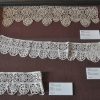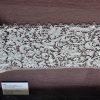Origins.The triple-petalled golden corollas on the fringes enriching the purple mantle of mosaic madonnas in the apses at Torcello, Murano and in the most ancient of St. Mark’s mosaics (11th–13th centuries), which would disappear from Venetian images after 1204 with the victory over Constantinople and the emancipation of Venice from Byzantine dominion, were possibly executed with bibila stitches, a needle-point still carried out in Aegean islands and which would represent itself in an identical fashion in Veneto-Cretan icons in the 15th century. Instead, the needle lace which developed in Renaissance Venice, even though stemming from that initial origin, is a different, complex and advanced ensemble of manifold stitches and, as in bobbin lace, it was the creative and manual expression of aristocratic female sensitivity, cultured thanks to close contact with refined artistic and intellectual circles. The first decorations were essentially geometric and ornamented the neckline and corners of handkerchiefs.
16th century. The 16th century was witness to an interesting editorial boom (in Europe, in Italy, and especially in Venice), featuring the publication of hundreds of books, called modellari or pattern-books, with designs for lace and embroidery, conceived by the greatest engravers and typographers of the time. Dedicated to the noble and virtuous women who executed the art within the intimacy of their home, they show a preference for geometrical decorations, arabesques, rosettes, subsequently becoming more elaborate in the second half of the century, with botanical-zoomorphic and grotesque elements. Lace-making activity in monasteries and in the laboratories of orphanages and charitable institutes were documented already in the late 16th century and afterwards, due to the extraordinary success of lace in fashion both in clothing and in furnishings, seeing that such kinds of family and convent production were no longer sufficient, other types were organised on a much larger scale, involving entire female populations concentrated in isolated localities, in order to make exploitation more worthwhile.





